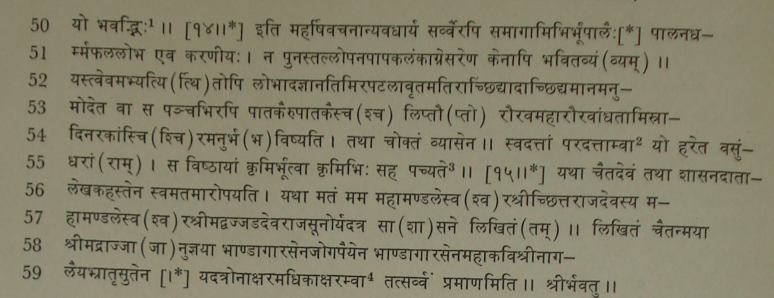|
The Indian Analyst
|
North Indian Inscriptions |
INSCRIPTIONS OF THE SILAHARAS OF NORTH KONKAN
TRANSLATION Success ! May there be victory and prosperity ! ..[For the translation of verses 1 to 9, see that of verses 1, 2, 4-10 respectively of the Ṭhāṇā plates of Arikēsarin (No. 8), above p. 51.]. .. (Verse 10). From him was born the elder son named Vajjaḍadēva and then the illustrious brother Kesideva[5]. .. (Verse 11). Next his nephew, the illustrious Chhittarāja, became king; the great prince, who, though a child, raised the Śīlāra race to high eminence.
.. (Line 16). Now, while the Mahāmaṇdalēśvara, the illustrious Chittarājadēva,-who, by his religious merit, has obtained the right to the five mahāśabdas and who is adorned with all royal titles such as Mahāsāmantādhipati, ‘the lord of the City of Tagara’, ‘a king of the Śilāhāra family’, ‘a scion of the famly of Jīmūtavāhana,’ ‘(he) who has the ensign of the golden Garuḍa’, ‘(he) who is a born Vidyādhara’[6], ‘(he) who has surpassed the world in liberality’, “(he) who is the crest-jewel of (i.e. the foremost among) the Māṇḍalikas’, ‘(he) who is an admantine cage to suppliants’ and so forth-is ruling over the entire Kōṅkaṇa country consisting of fourteen hundred village headed y Purī, together with several maṇḍalas conquered by his own arm, and while the five ministers such as the Sarvādhikārin,the illustrious Nāgaṇnaiyam the Sāndhivigrahika, the illustrious Sīhapaiya, the Karṇāṭa-Sāndhivigrahika, the illustrious Kapardin and the Śrīkaraṇa[7] are shouldering the burden of the cares of his government,- at this time the Mahāmaṇḍalēśvara, the illustrious Chhittarājadēva addresses, with salutation, honour and respect, all the assembled princes, counselors, the family priest, the ministers, the principal and subordinate officers, whether connected with him or not, as well as the heads of the rāshṭras, vishayas, towns, villages, officials and non-officials, government servants and village people as also artisans[8], guilds and the three classes of townsmen and others as follows: ..
âBe it known to you that realising that prosperity is unsteady, youth is momentary and [1] Metre : Śālinī.
|
|||||||||||||||||||||||||||||||||||||||||||||||||||||||||||||||||||||||||||||||||||||||||||||||||||||||||||||||||||||
| > |
|
>
|








